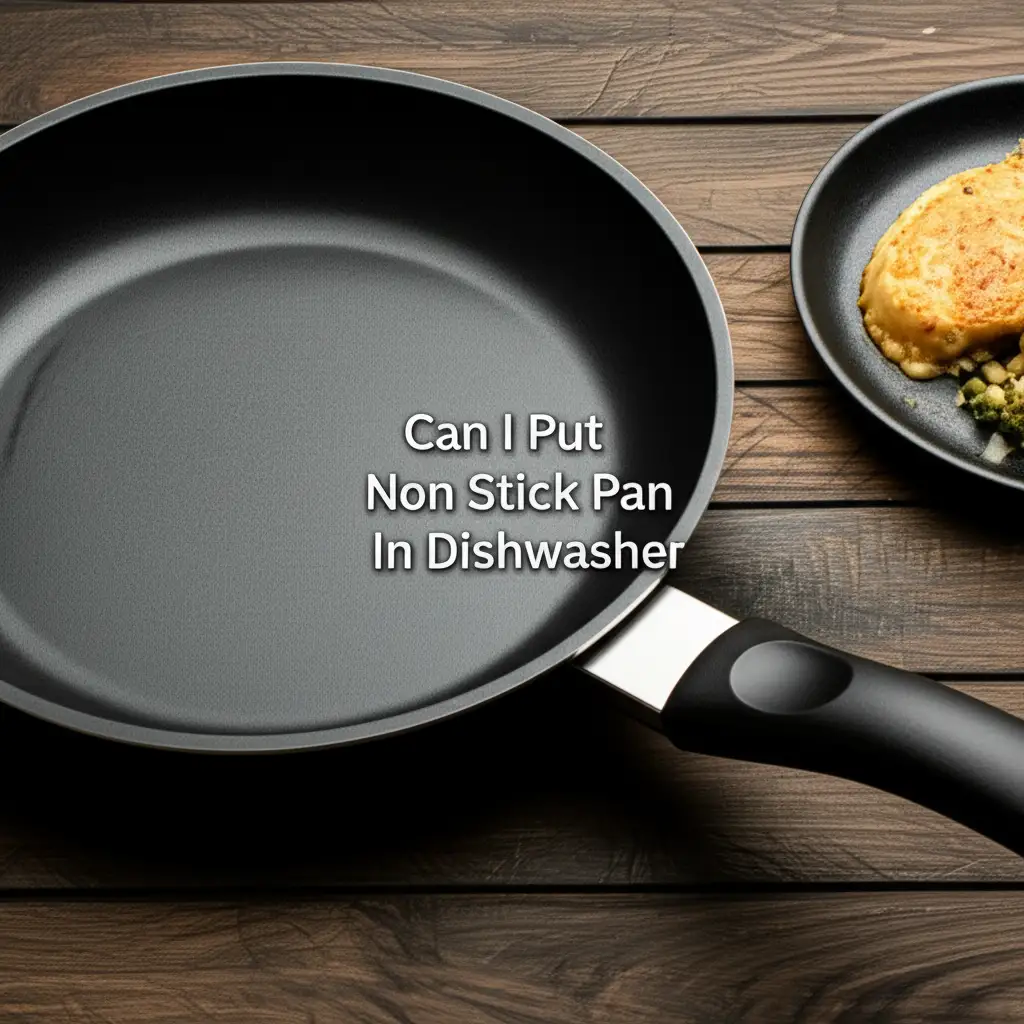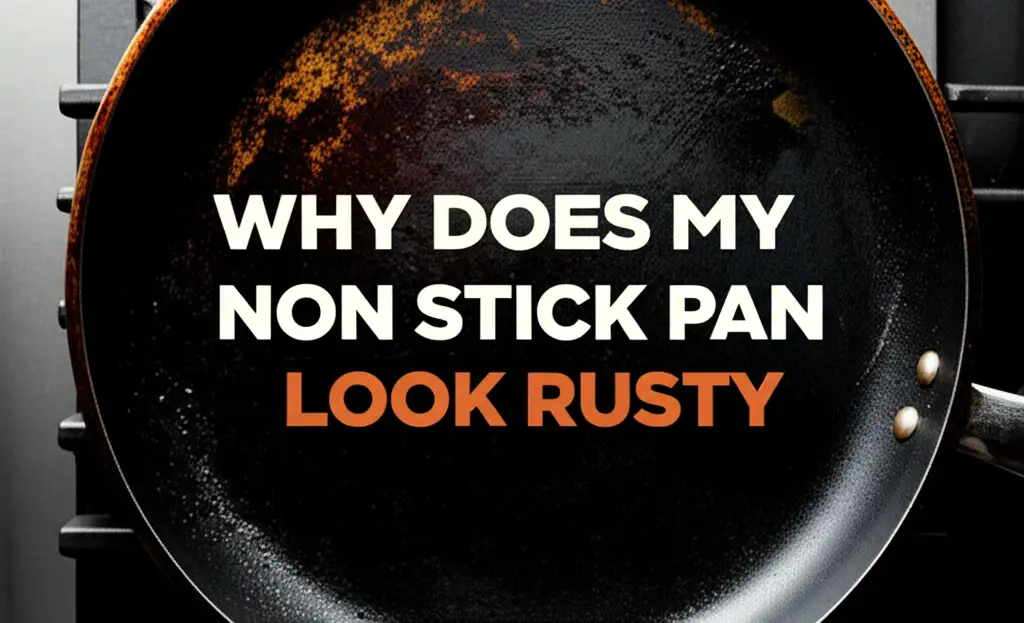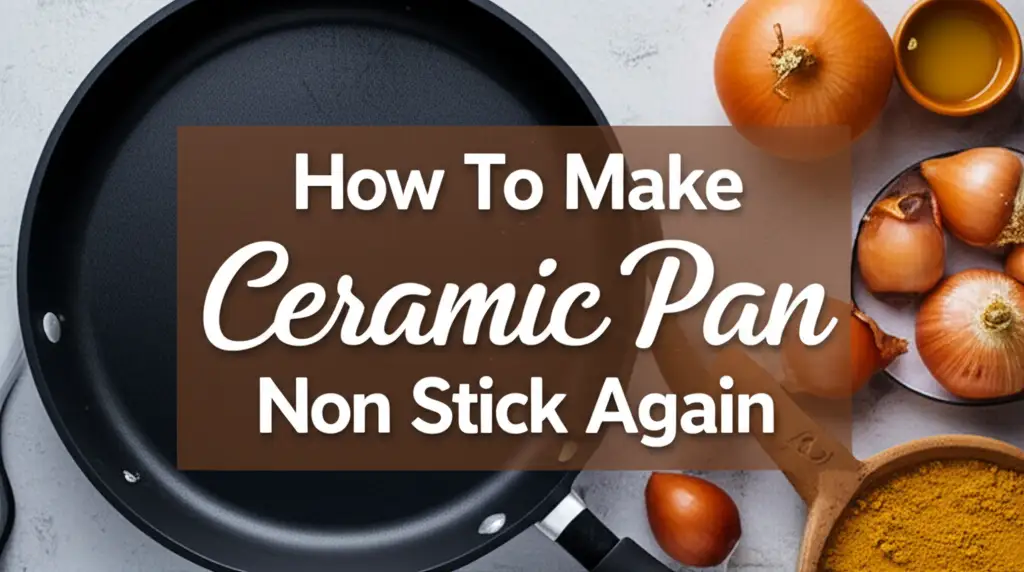· Katria Melrose · Cookware Care · 18 min read
Can I Put Non Stick Pan In Dishwasher

Can I Put Non Stick Pan In Dishwasher? The Truth About Dishwasher Safety
We all love the convenience of a dishwasher. It saves time and effort, making kitchen cleanup a breeze. However, when it comes to specific items like your beloved non-stick pan, a common question arises: “Can I put non-stick pan in dishwasher?” It is a vital question for anyone who wants to protect their cookware. The answer is not always a simple yes or no. Understanding the impact of the dishwasher on non-stick coatings is important for maintaining your pans and ensuring their longevity.
This article will explain why dishwashers can be harsh on non-stick surfaces. We will look at what happens to the coating and how to determine if your pan is truly “dishwasher safe.” You will also find practical advice for cleaning your non-stick pans by hand. Proper care extends the life of your cookware. Let’s explore how to keep your non-stick pans performing their best for years to come.
Takeaway
- Avoid Dishwashers: Most non-stick pans are not dishwasher safe, despite some labels.
- Harsh Environment: Dishwasher detergents, high heat, and intense water jets degrade non-stick coatings.
- Hand Wash Preferred: Always hand wash non-stick pans with mild soap and a soft sponge for best results.
- Check Manufacturer Guidelines: Always check the pan’s care instructions for specific recommendations.
- Protect Your Investment: Proper hand washing extends pan life and maintains non-stick performance.
A Clear Answer: Can I Put Non Stick Pan In Dishwasher?
Generally, it is best to avoid putting your non-stick pan in the dishwasher. While some manufacturers claim their non-stick pans are “dishwasher safe,” the harsh detergents, high water temperatures, and strong jets in a dishwasher can still damage the delicate non-stick coating over time. Hand washing is almost always the recommended method for preserving your non-stick cookware’s performance and lifespan.
Understanding Non-Stick Coatings and Dishwasher Impact
Non-stick coatings, typically made from PTFE (Teflon) or ceramic, provide a smooth surface that prevents food from sticking. This coating is quite delicate. It can be easily damaged by abrasive cleaners or excessive heat. When we talk about putting a non-stick pan in the dishwasher, we are exposing this sensitive surface to a harsh environment. This environment includes powerful chemicals and extreme temperatures.
The dishwasher uses strong detergents designed to strip away grease and food particles. These detergents contain abrasive chemicals. They can erode the non-stick layer bit by bit. Over time, this erosion makes the coating less effective. Your pan will start to stick. The high heat inside the dishwasher also plays a role. Intense heat can cause the non-stick material to break down. This weakens its bond to the pan’s base. For optimal care, remember that the gentlest approach is often the best for preserving your non-stick surface.
Additionally, the powerful water jets in a dishwasher can physically abrade the non-stick surface. Repeated exposure to these strong streams can lead to tiny scratches or peeling. This damage compromises the pan’s non-stick properties. Once the coating starts to degrade, food begins to stick, and the pan’s usability decreases significantly. Hand washing protects the pan from these physical forces. It ensures the non-stick surface remains intact and effective. Many people wonder why you should not use non-stick pan for certain tasks, and proper cleaning is a big part of maintaining its integrity and safety.
Why Dishwashers Can Harm Non-Stick Pans
Dishwashers create an environment that is often too aggressive for the delicate surface of non-stick pans. The primary culprits are high temperatures, harsh detergents, and vigorous water jets. These three factors work together to degrade the non-stick coating. They reduce your pan’s effectiveness and lifespan. Understanding these risks helps you make informed choices about your cookware care.
High Heat Exposure
Dishwashers operate at very high temperatures. This heat is necessary for sanitizing dishes and melting away grease. However, non-stick coatings are not designed to withstand such extreme heat repeatedly. Prolonged exposure can cause the coating material to break down. It can also lead to warping of the pan’s base. Warping makes the pan uneven, affecting cooking performance.
Abrasive Detergents
Dishwasher detergents are formulated to be very powerful. They contain strong chemicals and abrasive agents. These agents are excellent at cleaning tough food residues from plates and cutlery. However, for a non-stick surface, these chemicals are too harsh. They can strip away the non-stick layer. This stripping happens gradually, but it is irreversible. Once the coating starts to erode, your pan loses its non-stick properties. It can also become harder to clean.
Vigorous Water Jets and Physical Damage
The powerful spray of water inside a dishwasher is another source of potential damage. These jets are designed to blast food off dishes. For a delicate non-stick surface, this can be too aggressive. Repeated bombardment by strong water streams can cause micro-scratches on the coating. These tiny scratches eventually lead to peeling. Once peeling begins, the pan is essentially ruined. It becomes unsafe to use and loses its non-stick capabilities entirely. This physical abrasion is a significant reason why hand washing is always preferred. If you are struggling with a pan that has lost its stick resistance, learning how to make ceramic pan non-stick again or revive other types of non-stick pans can be helpful.
Identifying “Dishwasher Safe” Non-Stick Cookware
Many manufacturers label their non-stick pans as “dishwasher safe.” This label can be confusing for consumers. It suggests that the pan will endure the dishwasher without issue. However, “dishwasher safe” often means the pan will not be immediately ruined. It does not mean the non-stick coating will maintain its integrity indefinitely. The term “dishwasher safe” implies a certain level of resistance, not immunity.
When you see this label, it usually indicates that the pan’s materials, such as the handle and base, can withstand dishwasher cycles without melting or severely deforming. It rarely guarantees the long-term preservation of the non-stick coating itself. The harsh environment of a dishwasher will still degrade the non-stick surface over time. This degradation occurs even on “dishwasher safe” models. The process might be slower than with pans not labeled as such, but it is inevitable.
To truly identify “dishwasher safe” non-stick cookware, look for specific assurances from the manufacturer. Some high-end brands use advanced, more durable non-stick formulations. They might withstand dishwasher cycles better. Even then, most experts and manufacturers still recommend hand washing for maximum longevity. Always check the pan’s care instructions for the most accurate guidance. If the pan does not explicitly state “dishwasher safe,” assume it is not. Even if it does, consider hand washing as the best method. If you’ve ever wondered can you wash non-stick pan in dishwasher and found conflicting information, this distinction is key.
Best Practices for Hand Washing Non-Stick Pans
Hand washing is the gold standard for cleaning non-stick pans. It is gentle on the delicate coating and helps preserve the pan’s non-stick properties for many years. Adopting these best practices will extend the life of your cookware significantly. Proper hand washing is simple and quick, especially if you clean the pan right after use.
Immediate Cleanup After Use
The best time to clean your non-stick pan is right after you finish cooking. Let the pan cool down completely first. Pouring cold water into a hot pan can cause thermal shock. Thermal shock can lead to warping or damage to the coating. Once the pan is cool, cleaning is much easier. Food residues will not have hardened onto the surface.
Use Mild Soap and Soft Tools
Always use a mild dish soap for cleaning. Avoid abrasive cleaners or strong detergents. These can strip away the non-stick coating. For scrubbing, choose a soft sponge, a dishcloth, or a silicone brush. Never use steel wool, abrasive scouring pads, or metal utensils. These will scratch the non-stick surface, ruining its effectiveness.
Materials to Use:
- Mild dish soap
- Soft sponge
- Dishcloth
- Silicone brush
Materials to Avoid:
- Abrasive cleaners
- Steel wool
- Metal scrubbers
- Harsh detergents
Gentle Washing Technique
Fill the pan with warm water and a small amount of mild soap. Let it sit for a few minutes if there are stubborn food bits. This helps to loosen any stuck-on food. Then, gently wipe the surface with your soft sponge. The non-stick coating usually releases food easily. Rinse the pan thoroughly with warm water. Make sure no soap residue remains. Dry the pan immediately with a soft cloth to prevent water spots and rust, especially on the rim or handle connections. If you ever have a really tough spot, learning how to clean a burnt non-stick pan can save your pan.
Proper Drying and Storage
After washing, always dry your non-stick pan completely. Leaving water on the pan can lead to mineral deposits or even rust on exposed metal parts. Store your pan carefully. Do not stack other pots or pans directly inside it without protection. Use pan protectors, paper towels, or soft cloths between stacked pans. This prevents scratches to the non-stick surface from other cookware. Proper storage is as important as proper washing for longevity.
Extending the Life of Your Non-Stick Cookware
Taking good care of your non-stick pans involves more than just how you wash them. It encompasses daily cooking habits and storage. By following a few simple rules, you can significantly extend the lifespan of your non-stick cookware. This means your pans will perform better and last longer, saving you money in the long run.
Seasoning and Maintenance
Some non-stick pans, especially ceramic ones, benefit from occasional seasoning. This process helps maintain the non-stick properties. Check your pan’s manufacturer instructions for seasoning recommendations. Typically, it involves applying a thin layer of cooking oil and heating the pan gently. This creates a protective layer. For example, if you just purchased a new pan, knowing how to clean non-stick pan before first use is a great initial step in proper care.
Avoid Metal Utensils
Never use metal spatulas, spoons, or whisks on non-stick surfaces. Metal utensils can easily scratch and chip the delicate coating. Once scratched, the non-stick property is compromised, and the pan can become unsafe. Always opt for wooden, silicone, or plastic utensils. These materials are much gentler and will not damage the surface.
Control Cooking Temperatures
Non-stick pans perform best at low to medium heat settings. High heat can damage the non-stick coating over time. It can also cause the pan to warp. Avoid preheating an empty non-stick pan on high heat. Add a little oil or food before heating. Using appropriate heat settings protects the coating and ensures even cooking. For example, knowing can you cook steak on non-stick pan involves understanding temperature limits.
Proper Storage Techniques
Storing your non-stick pans correctly is crucial. Do not stack them directly on top of each other without protection. The bottom of one pan can scratch the non-stick surface of the pan below it. Use pan protectors, felt pads, or even paper towels between stacked pans. Hanging pans is also an excellent option if you have the space. This prevents any contact damage.
By consistently applying these care tips, you will ensure your non-stick pans remain effective and durable. Proper care translates to better cooking results and a longer return on your cookware investment.
The Long-Term Impact of Dishwasher Use on Non-Stick
Repeated exposure to the dishwasher’s harsh environment takes a toll on non-stick pans. The damage might not be visible after one or two washes, but it accumulates over time. This long-term degradation leads to several undesirable outcomes. Your pan will eventually lose its primary function: preventing food from sticking.
Firstly, the non-stick coating erodes. Each dishwasher cycle, with its strong detergents and hot water, strips away a tiny layer of the coating. This process is like sandpaper on wood; imperceptible at first, but ultimately destructive. As the coating thins, food starts to cling to the pan. You will notice eggs sticking, and pancakes tearing. This makes cooking frustrating and cleanup difficult. Many people eventually ask, why does my new non-stick pan stick, and often, improper cleaning methods like dishwashing are a contributing factor.
Secondly, the pan’s physical integrity can suffer. High heat in the dishwasher can cause the pan’s base to warp. A warped pan does not sit flat on the stove. This leads to uneven heating and poor cooking results. It also becomes less stable on the burner. The handles, especially if they are made of plastic or certain types of metal, can also weaken or loosen over time due to repeated heat exposure and strong water jets. This affects the pan’s safety.
Finally, the flaking or peeling of the non-stick coating is a major concern. Once the coating starts to peel, it can mix with your food. While small amounts of non-stick coating are generally considered inert and harmless if ingested, it is certainly not ideal. This flaking indicates the pan is past its prime. It needs replacement. To avoid these long-term issues, hand washing your non-stick pans is the most effective preventative measure. This protects your investment and ensures safe, easy cooking for years to come.
Common Myths About Non-Stick Pan Care
There are many misconceptions about how to care for non-stick pans. Some myths can actually cause damage to your cookware. Dispelling these common beliefs helps ensure you are providing the best possible care for your non-stick surfaces. Let’s clear up some common misunderstandings.
Myth 1: “Dishwasher Safe” Means No Damage
As discussed, “dishwasher safe” on non-stick pans usually means the pan won’t immediately fall apart. It does not mean the non-stick coating will last forever. The harsh dishwasher environment still degrades the coating over time. The label primarily indicates the pan’s structural components (like handles and base) can endure the machine. Always hand wash for true longevity.
Myth 2: Non-Stick Pans Last Forever
No cookware lasts forever, and non-stick pans are no exception. The non-stick coating naturally degrades with use, even with the best care. Scratches, high heat exposure, and general wear and tear contribute to its eventual decline. Proper care extends its life significantly, but it will eventually need replacement. Expect a good quality non-stick pan to last several years with proper hand washing.
Myth 3: High Heat Improves Non-Stick Performance
This is false and harmful to non-stick pans. High heat can actually break down the non-stick coating. It can also cause harmful fumes to release. Non-stick pans are designed for low to medium heat cooking. Always preheat non-stick pans gently. Use appropriate heat settings for the best results and coating preservation. Using metal utensils at high heat can accelerate the damage; for effective cleaning, consider methods like how to clean non-stick frying pan rather than relying on harsh scrubbing.
Myth 4: You Don’t Need Oil on Non-Stick Pans
While non-stick pans are designed to cook with minimal oil, using a small amount is still recommended. A tiny bit of cooking oil or butter helps distribute heat more evenly. It also enhances the non-stick properties. It also contributes to browning and flavor development. Completely dry cooking can sometimes lead to food sticking or uneven cooking.
Myth 5: A Scratched Non-Stick Pan is Still Fine to Use
Once a non-stick pan is scratched or peeling, its effectiveness is compromised. Additionally, small pieces of the coating can flake into your food. While current research suggests ingesting small amounts of non-stick coating is not harmful, it is certainly not ideal. A severely scratched or peeling non-stick pan should be replaced for best cooking results and peace of mind.
Understanding these truths helps you provide the best care for your non-stick pans. It ensures they remain effective and safe for cooking.
The Financial and Environmental Cost of Dishwasher Damage
Beyond the immediate inconvenience of a ruined pan, regularly putting non-stick pans in the dishwasher carries financial and environmental consequences. Understanding these broader impacts can reinforce the importance of proper cookware care. Choosing to hand wash your non-stick pans contributes to both your wallet and the planet.
Financially, frequently replacing non-stick pans adds up. A good quality non-stick pan is an investment. If its lifespan is cut short by dishwasher use, you are essentially throwing money away. Hand washing, which typically takes only a minute or two, preserves that investment. You save money by not needing to buy new pans as often. This makes proper care a cost-effective choice in the long run.
Environmentally, discarded non-stick pans contribute to landfill waste. Many non-stick pans are difficult to recycle due to their mixed materials (metal base, non-stick coating, various handle compositions). When a pan is ruined prematurely, it adds to this waste stream. By extending the life of your non-stick cookware through careful hand washing, you reduce your personal contribution to waste. This supports more sustainable consumption habits.
Moreover, the manufacturing process for new pans consumes energy and resources. By maximizing the usable life of your existing pans, you reduce the demand for new production. This lessens the overall environmental footprint associated with cookware. Opting for hand washing is a small but significant step towards more responsible consumption and waste reduction. For instance, if you are curious about how to clean non-stick pan with vinegar and baking soda, these eco-friendly cleaning methods can further support both your pan’s longevity and environmental responsibility.
The Role of Manufacturer’s Instructions in Pan Care
Always refer to the manufacturer’s specific care instructions that come with your non-stick pan. These guidelines are the most authoritative source of information for your particular piece of cookware. Manufacturers design their products with specific materials and coatings. They provide instructions tailored to those unique compositions. Ignoring these guidelines can void warranties and lead to premature pan failure.
Manufacturers often include detailed advice on washing, heating, and storage. Some high-end non-stick pans might use more robust coatings designed to withstand dishwasher cycles better than others. However, even with these, the instructions might still recommend hand washing for optimal longevity. This is because they understand the long-term impact of dishwasher environments. For example, if you own specific brands, knowing how to clean non-stick All-Clad pan might involve unique recommendations.
The care instructions are usually found in a booklet accompanying the pan. If you no longer have it, check the manufacturer’s website. Most reputable brands provide downloadable care guides online. Following these specific instructions ensures you are treating your pan exactly as its creators intended. This simple step is vital for protecting your investment. It guarantees the best possible performance and lifespan from your non-stick cookware.
FAQ Section
Is any non-stick pan truly dishwasher safe?
While some manufacturers label non-stick pans as “dishwasher safe,” this usually means the pan’s structure can withstand the machine. The delicate non-stick coating itself still degrades over time from harsh detergents, high heat, and strong water jets. For maximum longevity and performance, hand washing is always recommended, even for “dishwasher safe” models.
What happens if I put a non-stick pan in the dishwasher?
Putting a non-stick pan in the dishwasher can cause the coating to degrade, becoming less effective and causing food to stick. High heat can warp the pan, and strong detergents can erode the non-stick surface. Over time, this leads to peeling or flaking of the coating, making the pan unusable.
How often should I wash my non-stick pan by hand?
You should hand wash your non-stick pan after every use. Allow the pan to cool completely before washing. Use mild dish soap and a soft sponge. This immediate and gentle cleaning prevents food from sticking and preserves the non-stick coating effectively for long-term use.
Can high heat settings in the dishwasher ruin non-stick?
Yes, high heat settings in the dishwasher can certainly ruin non-stick pans. Non-stick coatings are sensitive to extreme temperatures. Repeated exposure to the intense heat found in dishwashers can cause the coating to break down, peel, or even cause the pan itself to warp.
What kind of soap should I use for hand washing non-stick pans?
For hand washing non-stick pans, use a mild dish soap. Avoid abrasive cleaners, scouring powders, or harsh detergents. These can scratch or strip the delicate non-stick surface. Gentle liquid dish soap and a soft sponge are the best tools for effective and safe cleaning.
How do I know if my non-stick pan is ruined and needs replacing?
Your non-stick pan is likely ruined if food consistently sticks to it, even after proper cleaning and oiling. Other signs include visible scratches, peeling, flaking, or bubbling of the non-stick coating. A warped base that prevents even heating also indicates it’s time for replacement.
Conclusion
The question “Can I put non-stick pan in dishwasher?” is common, and the answer, while nuanced, generally points toward caution. While modern advancements have led to some “dishwasher safe” non-stick cookware, the reality is that the harsh environment of a dishwasher—high temperatures, aggressive water jets, and strong detergents—will inevitably shorten the lifespan of even the most durable non-stick coating. Protecting your investment and enjoying the benefits of truly non-stick cooking relies heavily on proper care.
Hand washing your non-stick pans with mild soap and a soft sponge remains the gold standard. This simple act safeguards the delicate coating, prevents warping, and ensures your pan continues to perform optimally for years. By avoiding the dishwasher, controlling cooking temperatures, using appropriate utensils, and storing your pans carefully, you contribute significantly to their longevity. Prioritize these gentle care practices to extend the life of your non-stick cookware. Keep cooking easy and enjoyable without worrying about sticky situations. Make the choice today to hand wash and preserve your valuable kitchen tools.
- non-stick pans
- dishwasher safety
- cookware maintenance
- kitchen cleaning tips
- pan care
- non-stick coating
- hand washing
- kitchen essentials





